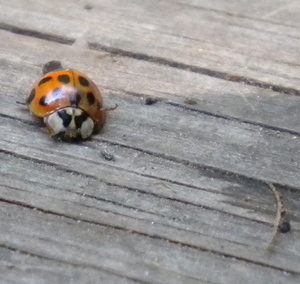Citizen scientists: easy ideas for kids and adults to study the environment

Is this one of our Lost Ladybugs?
You don’t need a background in science to become a citizen scientist. You simply need to have an interest in the topic, take note of the world around you and record your observations. Your efforts can help professional scientists in their research about the natural world around us, even in urban areas. Although observers don’t need to be adults to participate, adult supervision and confirmation of observations is required.
My friend, George Hammond, editor of the University of Michigan Animal Diversity Web and the parallel BioKids Web site, has shared with me several ongoing nationwide science initiatives that requires input from citizen scientists. In general, participation is easy. Simply provide your contact information, follow a few simple guidelines, and submit your data as frequently as you can.
Some of these projects are seasonal, and the observation window has passed for 2010. But please keep them in mind for future years.
The Lost Ladybug Project
Native ladybugs have disappeared from lots of places, perhaps displaced by waves of exotics. This project, with lots of kid-friendly resources, is trying to collect records about where different species are found. You’ll be submitting digital pictures of ladybugs you encounter.
The Great Sunflower Project
Despite the name, this is actually a project studying bee populations, which have been on the decline in recent years. In this project, you’ll grow flowers, watch for pollinators and report what you see. Lemon Queen Sunflower Seeds are available for $3. Sunflowers are easy to grow, but the project does suggest other flowers to monitor.
Firefly Watch
This is one of the newer projects, so it’s not as big. But it’s still pretty cool. No specific scientific training is required.
Fall:
Project Feeder Watch
Beginning in mid-November through mid-April, identify and count the birds at your feeders. Anyone who has an interest in birds can participate. There is a $15 annual participation fee which funds the project.
Project Budburst
By collecting observations of plant growth and development timing, you will help document impacts of climate change. Plants are blooming sooner. This is a big project, with lots of teaching support, and is very easy to participate.
Journey North
A classic. Journey North has been monitoring monarch butterflies as they travel from their winter grounds in Mexico to the rest of North America for years. This project provides lots and lots of teaching support. Besides monarchs, participants can monitor other organisms, like: hummingbirds, American robins, gray whales, whooping cranes, earthworms, tulip gardens and more.
Stefan Szumko is a middle school science teacher by trade, an outdoor environmental educator by calling, and a homedaddy by choice. Stefan can be contacted at slugwhisperer@gmail.com.


Comments
Erica Lanni
Fri, Jun 25, 2010 : 7:24 a.m.
I love the idea of citizen scientist programs. I think it gives students a more authentic experience of being a scientist, including the patience needed to do science and uncertainty of some of your results. The SHArK project, from the University of Wyoming is another great program. The researcher behind it recently came and spoke at U-M Chemistry department. It is designed for high school level student participants. I found it totally fascinating! http://www.thesharkproject.org/
Stefan Szumko
Tue, Jun 22, 2010 : 11:47 p.m.
mkm17 - Ah yes. GLOBE is another great worldwide educational resource, water sampling, weather observations, soil studies, land cover, and other environmental monitoring. Training is required for participation. If anyone knows of a generous sponsor, I know of a local Science and Nature Center that might be interested in implementing this program. Ed - Thanks for sharing the BAP. I look forward to exploring it further with my boys. I'm sure they'll get a kick out of it. I know I'll be able to use the info when researching my Pondcasts.
robyn
Tue, Jun 22, 2010 : 8:15 p.m.
These are great - I need to mark the sites. There are a couple my kids will just love! Thanks!
Scott Beal
Tue, Jun 22, 2010 : 5:11 p.m.
I appreciate this idea of the citizen scientist. There are many ways of knowing the world. An individual's findings may be limited and inconclusive without the rigors applied by the professional, but that does not necessarily disqualify them as unscientific.
Stefan Szumko
Tue, Jun 22, 2010 : 8:39 a.m.
Thank you, sir. I'm glad you enjoy it.
mkm17
Tue, Jun 22, 2010 : 8:39 a.m.
GLOBE (Global Learning and Observations to Benefit the Environment) is another great program. Tens of thousands of K-12 schools (including my very own school in South Lyon) participate. http://www.globe.gov
Barb
Tue, Jun 22, 2010 : 8:38 a.m.
I love these!
Ross
Tue, Jun 22, 2010 : 8:20 a.m.
great stuff Stefan!